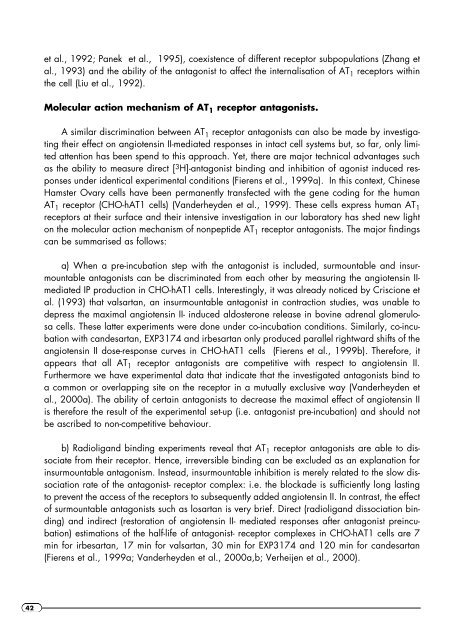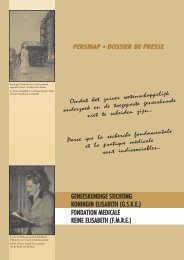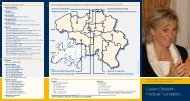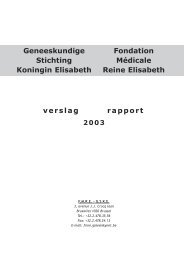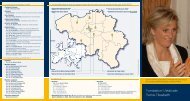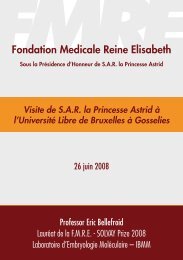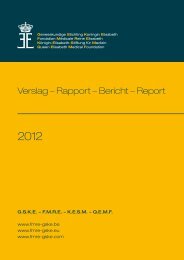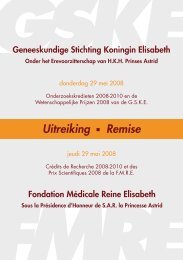Geneeskundige Stichting Koningin Elisabeth ... - GSKE - FMRE
Geneeskundige Stichting Koningin Elisabeth ... - GSKE - FMRE
Geneeskundige Stichting Koningin Elisabeth ... - GSKE - FMRE
Create successful ePaper yourself
Turn your PDF publications into a flip-book with our unique Google optimized e-Paper software.
42<br />
et al., 1992; Panek et al., 1995), coexistence of different receptor subpopulations (Zhang et<br />
al., 1993) and the ability of the antagonist to affect the internalisation of AT 1 receptors within<br />
the cell (Liu et al., 1992).<br />
Molecular action mechanism of AT 1 receptor antagonists.<br />
A similar discrimination between AT 1 receptor antagonists can also be made by investigating<br />
their effect on angiotensin II-mediated responses in intact cell systems but, so far, only limited<br />
attention has been spend to this approach. Yet, there are major technical advantages such<br />
as the ability to measure direct [ 3H]-antagonist binding and inhibition of agonist induced responses<br />
under identical experimental conditions (Fierens et al., 1999a). In this context, Chinese<br />
Hamster Ovary cells have been permanently transfected with the gene coding for the human<br />
AT 1 receptor (CHO-hAT1 cells) (Vanderheyden et al., 1999). These cells express human AT 1<br />
receptors at their surface and their intensive investigation in our laboratory has shed new light<br />
on the molecular action mechanism of nonpeptide AT 1 receptor antagonists. The major findings<br />
can be summarised as follows:<br />
a) When a pre-incubation step with the antagonist is included, surmountable and insurmountable<br />
antagonists can be discriminated from each other by measuring the angiotensin IImediated<br />
IP production in CHO-hAT1 cells. Interestingly, it was already noticed by Criscione et<br />
al. (1993) that valsartan, an insurmountable antagonist in contraction studies, was unable to<br />
depress the maximal angiotensin II- induced aldosterone release in bovine adrenal glomerulosa<br />
cells. These latter experiments were done under co-incubation conditions. Similarly, co-incubation<br />
with candesartan, EXP3174 and irbesartan only produced parallel rightward shifts of the<br />
angiotensin II dose-response curves in CHO-hAT1 cells (Fierens et al., 1999b). Therefore, it<br />
appears that all AT 1 receptor antagonists are competitive with respect to angiotensin II.<br />
Furthermore we have experimental data that indicate that the investigated antagonists bind to<br />
a common or overlapping site on the receptor in a mutually exclusive way (Vanderheyden et<br />
al., 2000a). The ability of certain antagonists to decrease the maximal effect of angiotensin II<br />
is therefore the result of the experimental set-up (i.e. antagonist pre-incubation) and should not<br />
be ascribed to non-competitive behaviour.<br />
b) Radioligand binding experiments reveal that AT 1 receptor antagonists are able to dissociate<br />
from their receptor. Hence, irreversible binding can be excluded as an explanation for<br />
insurmountable antagonism. Instead, insurmountable inhibition is merely related to the slow dissociation<br />
rate of the antagonist- receptor complex: i.e. the blockade is sufficiently long lasting<br />
to prevent the access of the receptors to subsequently added angiotensin II. In contrast, the effect<br />
of surmountable antagonists such as losartan is very brief. Direct (radioligand dissociation binding)<br />
and indirect (restoration of angiotensin II- mediated responses after antagonist preincubation)<br />
estimations of the half-life of antagonist- receptor complexes in CHO-hAT1 cells are 7<br />
min for irbesartan, 17 min for valsartan, 30 min for EXP3174 and 120 min for candesartan<br />
(Fierens et al., 1999a; Vanderheyden et al., 2000a,b; Verheijen et al., 2000).


